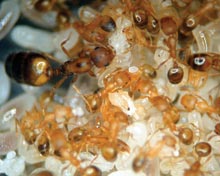
University of Nebraska-Lincoln Extension: http://lancaster.unl.edu/pest/

University of Nebraska-Lincoln Extension: http://lancaster.unl.edu/pest/
Pharoah Ant
General Description
The tiny (one-twelfth of an inch) pharaoh ant is yellow to reddish-brown. It is nearly identical to the thief ant
(Solenopsis molesta). However, the pharaoh has an “antennal club” consisting of three expanded segments on
the end of its antenna, while the thief ant has a two-segmented antennal club. Pharaoh ant nests are located in
floor voids, walls and ceilings, and they often infest large buildings. In hospitals, these ants pose a health risk
because they can carry infectious bacteria from the warm, moist areas they inhabit.
General Control
The colonies of this ant do not spread by swarming, but instead by “budding,” which is the breaking apart and
establishment of sub-colonies in new locations. This process can be triggered when the colony is stressed by the
application of repellent liquid or dust pesticides. Colonies can be very large, some containing more than 100,000
ants. Due to the fact that the colony may bud if stressed by an application of a insecticide or may quit foraging
after an application giving a false impression of eradication, baiting is the preferred method of control for pharaoh
ants. Several baits should be used to see which one the colony may prefer. Pharaoh ants notoriously use
plumbing pipes and electrical wires, therefore baiting in those locations is essential. Each ant trail found could be
to a separate ant colony, so baiting each trail and diagramming ant locations is very important in the eradication
of pharaoh ants.









